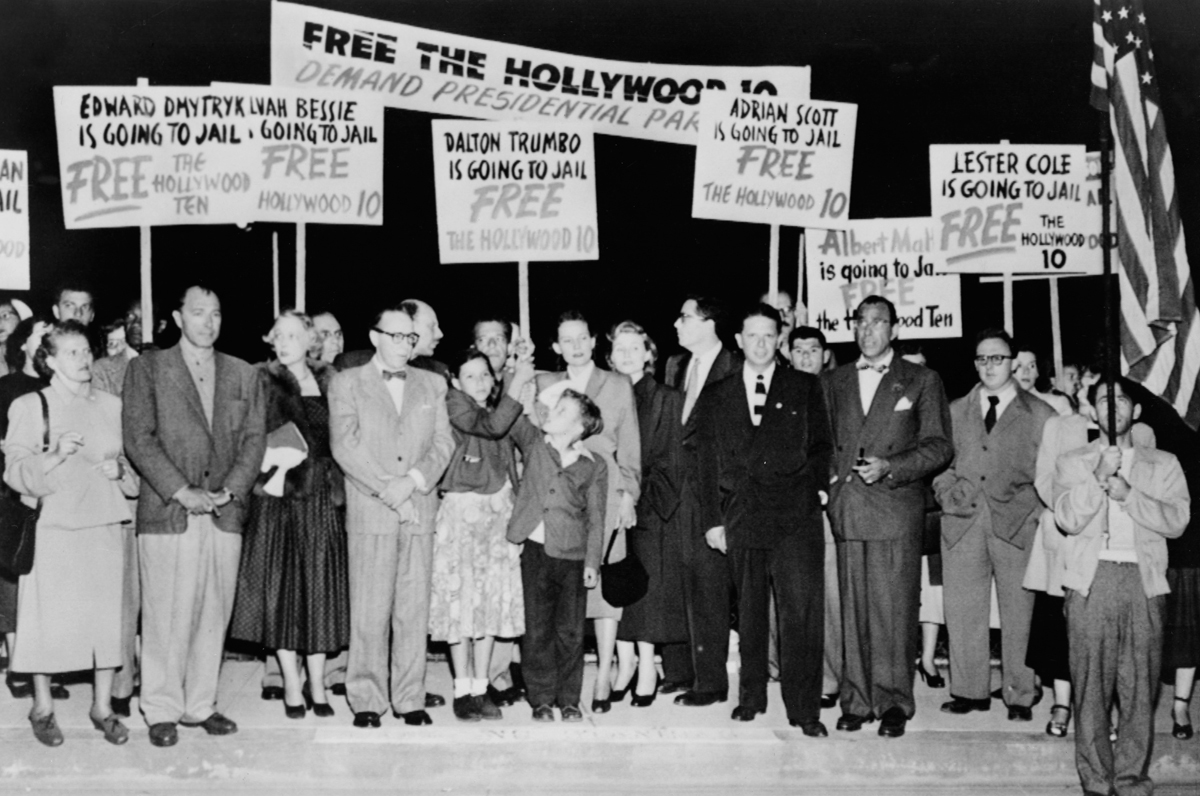The Transformation of the Studio System
After years of thriving, the Hollywood movie industry began to falter after 1946. Weekly movie attendance in the United States peaked at ninety million in 1946, then fell to under twenty-
The Hollywood Ten
In 1947, in the wake of the unfolding Cold War with the Soviet Union, conservative members of Congress began investigating Hollywood for alleged subversive and communist ties. That year, aggressive witch-
During the investigations, HUAC coerced prominent people from the film industry to declare their patriotism and to give up the names of colleagues suspected of having politically unfriendly tendencies. Upset over labor union strikes and outspoken writers, many film executives were eager to testify and provide names. For instance, Jack L. Warner of Warner Brothers suggested that whenever film writers made fun of the wealthy or America’s political system in their work, or if their movies were sympathetic to “Indians and the colored folks,”11 they were engaging in communist propaganda. Other “friendly” HUAC witnesses included actors Gary Cooper and Ronald Reagan, director Elia Kazan, and producer Walt Disney. Whether they believed it was their patriotic duty or they feared losing their jobs, many prominent actors, directors, and other film executives also “named names.”

THE HOLLYWOOD TEN
While many studio heads, producers, and actors “named names” to HUAC, others, such as the group shown here, held protests to demand the release of the Hollywood Ten. Everett Collection
Eventually, HUAC subpoenaed ten unwilling witnesses who were questioned about their memberships in various organizations. The so-
The Paramount Decision
Coinciding with the HUAC investigations, the government also increased its scrutiny of the movie industry’s aggressive business practices. By the mid-
Although the government had hoped to increase competition, the Paramount case never really changed the oligopoly structure of the Hollywood film industry because it failed to challenge the industry’s control over distribution. However, the 1948 decision did create opportunities in the exhibition part of the industry for those outside Hollywood. In addition to art houses showing documentaries or foreign films, thousands of drive-
Moving to the Suburbs
Common sense might suggest that television alone precipitated the decline in post–

MOVIES TAKE ON SOCIAL ISSUES
Rebel without a Cause (1955), starring James Dean and Natalie Wood, was marketed in movie posters as “Warner Bros. Challenging Drama of Today’s Teenage Violence!” James Dean’s memorable portrayal of a troubled youth forever fixed his place in movie history. He was killed in a car crash a month before the movie opened. Everett Collection
The transformation from a wartime economy and a surge in consumer production had a significant impact on moviegoing. With industries turning from armaments to appliances, Americans started cashing in their wartime savings bonds for household goods and new cars. Discretionary income that formerly went to buying movie tickets now went to acquiring consumer products, and the biggest product of all was a new house far from the downtown movie theaters—
Television Changes Hollywood
In the late 1940s, radio’s popularity had a strong impact on film. Not only were 1948 and 1949 high points in radio listenership, but with the mass migration to the suburbs, radio offered Americans an inexpensive entertainment alternative to the movies (as it had during the Great Depression). As a result, many people stayed home and listened to radio programs until TV displaced both radio and movies as the medium of national entertainment in the mid-
First, with growing legions of people gathering around their living room TV sets, movie content slowly shifted toward more serious subjects. At first, this shift was a response to the war and an acknowledgment of life’s complexity, but later movies focused on subject matter that television did not encourage. This shift began with film noir in the 1940s but continued into the 1950s, as commercial movies, for the first time, explored larger social problems such as alcoholism (The Lost Weekend, 1945), anti-
These and other films challenged the authority of the industry’s own prohibitive Motion Picture Production Code. Hollywood adopted the Code in the early 1930s to restrict film depictions of violence, crime, drug use, and sexual behavior and to quiet public and political concerns that the movie business was lowering the moral standards of America. (For more on the Code, see Chapter 16.) In 1967, after the Code had been ignored by producers for several years, the Motion Picture Association of America initiated the current ratings system, which rated films for age appropriateness rather than censoring all adult content.
Second, just as radio worked to improve sound to maintain an advantage over television in the 1950s, the film industry introduced a host of technological improvements to lure Americans away from their TV sets. Technicolor, invented by an MIT scientist in 1917, had improved and was being used in more movies to draw people away from their black-
Hollywood Adapts to Home Entertainment
Just as nickelodeons, movie palaces, and drive-
The future of the video business is in Internet distribution. Movie fans can download or stream movies and television shows for rent or for purchase from services like Netflix, Amazon, Hulu, Google Play, and the iTunes store to their television sets through devices like Roku, Apple TV, TiVo Premiere, video game consoles, and Internet-